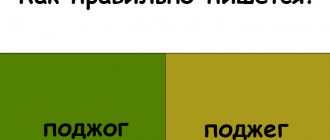Characteristics of concepts
Liability for intentional damage or destruction of property belonging to a person, organization or state is defined in the Criminal and Administrative Codes.
It is worth noting that in the Code of Administrative Offenses of the Russian Federation, the legislator indicates that an offense can only be committed intentionally. That is, in the case of arson due to negligence, provided that the result did not cause damage to the amount specified by law, the person will not be held accountable. The Criminal Code in Article 25 defines the concept of intent. Intention can be expressed in 2 forms:
- straight;
- indirect.
Direct intent means the perpetrator’s awareness of the social danger of his actions, foreseeing the inevitability or possibility of dangerous consequences and the desire for their occurrence.
Indirect intent consists of awareness of the social danger of an act, foreseeing the possibility of socially dangerous consequences, reluctance, but allowing such consequences and an indifferent attitude towards them.
An act can be qualified as an administrative offense if there is no significant damage as a result of arson. Responsibility measures are provided for in Article 7.17 of the Code of Administrative Offenses of the Russian Federation. The concept of significant damage is given in Article 158 of the Criminal Code of the Russian Federation. If the damage caused by the fire is less than 5 thousand rubles, then the act is considered an offense. The culprit faces an administrative fine in the amount of 300 to 500 rubles.
In the Criminal Code, punishment is provided for in Article 167. The perpetrator is subject to a fine of up to 40 thousand rubles, compulsory labor for 360 hours, forced labor for 2 years, and correctional labor for a year. The perpetrator can be imprisoned for up to 24 months or arrested for 3 months.
Important! The punishment increases if the act was committed out of hooligan motives or if it resulted in serious consequences, such as death, etc. The culprit is sentenced to five years in prison or forced labor for this period.
Article 25 of the Criminal Code of the Russian Federation “Crime committed intentionally”
Article 7.17 of the Code of Administrative Offenses of the Russian Federation “Destruction or damage to someone else’s property”
Article 158 of the Criminal Code of the Russian Federation “Theft”
Article 167 of the Criminal Code of the Russian Federation “Intentional destruction or damage to property”
Grammar
“Arson” is an inanimate masculine noun of the 2nd declension in the school tradition (I academic). Consists of the prefix “pod-” and the root “-zhog”. Case forms:
- Nominative: arson (singular); arson (plural).
- Genitive: arson (singular); arson (plural).
- Dative: arson (singular); arson (plural).
- Accusative arson (singular); arson (plural).
- Instrumental: by arson (singular); arson (plural).
- Prepositional: <about, about, in, on, with> arson (singular); <about, about, in, on, during> arson (plural).
The word “set fire” is a perfect, transitive and irrevocative verb of the 1st conjugation. Consists of the prefix “under-” and the root “-zhet”. Placement of stress and separation by hyphens . The corresponding imperfect verb is “to set fire”; intransitive “self-ignite” (colloquial synonym for “spontaneously combust”); reflexive “set yourself on fire” (attempt suicide by self-immolation or also a colloquial synonym for “get burned”).
Imperfection or perfection of the form of the verb indicates the incompleteness or completeness of the action: yes, this object (substance) is now being set on fire, but whether it will light up and flare up is still unclear, which means “to set fire” is an imperfect verb. But if it caught fire and is burning, yes, it was possible to set it on fire, it was set on fire, the action (set fire) was completed, the verb “set fire” is perfect.
“Transitional” means that the flammable material is not ignited by itself, but by someone or something (a spark from a short circuit, for example), that is, the action passes from the igniter to the ignited. But if, say, you throw on a lot of oily technical rags and leave them like that, then due to internal self-heating in the presence of atmospheric moisture, over time it will spontaneously ignite, self-ignite - the dangerous garbage will become its own arsonist, and the corresponding verb will be intransitive.
Non-reflexive means that the action is not directed towards itself (there is no postfix (after-ending) “-sya” or “-sya”). On the contrary, someone who commits self-arson (self-immolation; sad, but it happens), having doused himself with fuel, sets himself on fire.
The verb “to set fire” is conjugated according to persons in this way:
- (I) set fire (future)/ set fire (past male)/ set fire (past female)/ <would> set fire (set fire) or set fire (set fire) <by> (subjunctive)/ (I/ we) <must/should?> set fire or (I/you) <should?> necessary?> set fire (imperative).
- (We) will set fire (future)/ set fire (past)/ <would> set fire or set fire <would> (subjunctive)/ <should?> set fire or (I/we) <necessary?> set fire/< Let's set it on fire/set it on fire <-ka> (imperative).
- (You) will set fire (future)/ set fire (set fire) (past)/ set fire (set fire) or set fire set fire) (subjunctive)/ set fire (imperative).
- (You) will set fire to (future)/ set fire to (past)/ <to> set fire to or set fire <to> (subjunctive)/ set fire to (imperative).
- (He) will set fire (future)/ set fire (past)/ <would> set fire or set fire <would> (subjunctive)/ <Let> set fire (imperative).
- (She) will set fire (future)/ set fire (past)/ <would> set fire to or set fire <would> (subjunctive)/ <Let> set fire (imperative).
- (It) will set fire (future)/ set fire (past)/ <be> set fire to or set fire <by> (subjunctive)/ <Let> set fire (imperative).
- (They) will set fire (future)/ set fire (past)/ <be> set fire to or set fire <by> (subjunctive)/ <Let> set fire (imperative).
Active past participle set fire to ; passive set on fire Past participle set fire .
Forms of careless destruction or damage to someone else's property in the articles of the Criminal Code of the Russian Federation and the Code of Administrative Offenses of the Russian Federation
Criminal law establishes liability for persons whose actions resulted in damage or destruction of someone else's property through negligence.
As mentioned above, the Code of Administrative Offenses provides for the commission of an act only intentionally. Property damage occurs due to fire. The concept of negligence is considered in the Criminal Code of the Russian Federation in Article 26. The legislator says that there are two forms of this form of guilt:
- frivolity;
- negligence.
It is believed that the perpetrator acts out of frivolity when he foresees the possibility of dangerous consequences from his actions, but hopes to prevent them, without having sufficient grounds. In case of negligence, a person does not foresee the possibility of socially dangerous consequences, however, having shown the necessary care, he could and should have foreseen them.
When a crime is committed through negligence, it is classified as an act of minor gravity. The amount of punishment depends on what consequences occurred as a result of the fire. The culprit is liable under Article 168 of the Criminal Code of the Russian Federation.
Article 26 of the Criminal Code of the Russian Federation “Crime committed through negligence”
Article 168 of the Criminal Code of the Russian Federation “Destruction or damage to property through negligence”
Intended punishment
In cases where the arson was committed out of hooligan motives or resulted in the death of a person or other grave consequences, the offender may lose his freedom.
According to the law, such criminals are allowed to be given up to 5 years. The presence of significant damage plays an important role in determining the severity of the punishment. Property damaged by arson refers to any personal property of a person, including a car. This could be a house, apartment or any other building. If the actions of the criminal led to the victim receiving significant material damage, then liability for him arises on the basis of Part 1 of Art. 167 of the Criminal Code of the Russian Federation. In accordance with the sanction of this article of the Criminal Code, the arsonist may face:
- Fine up to 40 thousand rubles.
- Mandatory work (360 hours).
- Correctional labor (1 year).
- Forced labor (2 years).
- Imprisonment (up to 2 years).
There is a separate punishment for setting fire to a forest, field, etc. If the punishment for setting fire to someone else's house or car is criminal, then the punishment for creating a fire hazard will be administrative. Article 20.4 of the Code of Administrative Offenses contains the following sanctions for this offense:
- Individuals pay up to 5 thousand rubles.
- Officials pay up to 50 thousand rubles.
- Legal entities – no more than 400 thousand rubles.
If a minor citizen is prosecuted for this act, then the existence of liability depends on which part of Art. 167 is classified as arson. According to Part 1, responsibility begins at the age of 16, and according to Part 2 – at the age of 14. If the offender has not yet reached the required age, his parents are responsible for him.
There are several ways to avoid criminal liability for arson, and it is absolutely legal. Naturally, when the fire did not cause serious damage to property, health, etc.:
- the presence of active repentance (confession, assistance in the investigation);
- reconciliation of the parties;
- statute of limitations (more than 2 or 6 years).
In practice, half of the arson is committed due to hooliganism, and the second half is due to envy of the owners. And among the subjects of crime there are a lot of teenagers. But before you set fire to a car or house, you should think about what consequences this could lead to. Even with the most favorable outcome, this could result in a large fine and forced labor.
Object and subject of crime and offense
The object of a criminal act or offense is someone else's property.
This means that liability for causing damage to one’s property is not established. Important! At the legislative level, punishment is established for causing damage to one’s own property in cases where the goal was to receive an insurance payment. However, liability comes for committing fraudulent acts. The form of ownership does not matter, that is, it can be municipal, private or state property.
The objective side is expressed in the destruction or damage of someone else's property.
The subject in both cases will be a person who, at the time of committing the unlawful act, has reached the age of sixteen.
The subjective side in Article 7.17 of the Code of Administrative Offenses can be expressed by intent. In the Criminal Code, Article 167 deals with an intentional crime, and 168 - with a careless crime.
Destruction is considered as rendering a thing completely unusable, that is, its further use becomes impossible. Damage is understood as a decrease in integrity, which is restored as a result of repair.
How is the crime determined: reasons for arson
If a citizen has committed arson , then to qualify this crime, its elements are considered. Its important component is the subjective side of the act, since it could be committed with or without intent.
What does this mean:
- arson is considered committed with intent if a citizen set fire to someone else’s property and at the same time was fully aware of the negativity of his act, and also wanted serious consequences to occur;
- unintentional in cases where a person knew what the fire would lead to, but did not want its negative result.
The object of the offense is the objects of someone else's property: a vehicle, real estate, as well as the safety, health and life of citizens.
The objective side of the act is causing varying degrees of harm to someone else’s property or another person.
The subject of the crime is a legally competent citizen who has reached the required age by law.
The subject of arson is usually other people's property.
Evidence
To prove that the destruction of someone else's property as a result of arson actually took place, an investigation is conducted.
During it, evidence is collected that would help establish the reasons for the arson and how it was committed. This could be any explosive or chemical substances, abandoned matches, or lighters.
A survey is also conducted of those persons who were at the scene of the incident or nearby during the fire , CCTV camera records are reviewed, if any, and other citizens who could have filmed the incident on a photo or video camera are also involved.
Responsibility for arson of a door, car, barn
In the case where an attacker set fire to a car, barn or door of a residential premises, liability is provided for under Article 167 of the Criminal Code of the Russian Federation.
According to this norm, a fine of 40 thousand rubles may be collected from the perpetrator, as well as other types of punishment. If the property is insured, the insurance company will reimburse the full value of the property. Otherwise, you will need to apply to a judicial authority with a claim for compensation for the damage caused by the perpetrators. Video about Article 167 of the Criminal Code of the Russian Federation
What to do if you are threatened with arson?
There is no article in the Criminal Code of the Russian Federation that prescribes liability for the threat of arson of property (apartments, cars, doors, etc.).
It turns out that until property is damaged due to arson, then no one will be able to determine the crime.
However, for threatening to set a house on fire, a person can be held administratively liable by issuing a fine.
To prove that you are being threatened, you must:
Fine for setting fire to dry grass in the Russian Federation
Land owners should keep in mind that when dry grass is set on fire, they may not be able to control the flame, since during a gust of wind the fire can spread to nearby houses and plots.
In fact, the damage in this case is caused to the state, and its size is especially large. In addition, there may be situations where the culprit sets the grass on fire intentionally. The place of arson can be not only your own plot, but also any area where there is dried grass. If residential buildings were damaged as a result of a fire, a claim will be brought against the offender under civil law for compensation for the cost of the damage caused.
Article 167 or 168 of the Criminal Code of the Russian Federation is applicable to the violator, depending on the direction of intent and motives.
Qualification of the act
Any offense must be punished; every person who has violated the law must, after a thorough investigation, be brought to justice. For a speedy, fair investigation and identification of the true culprits of the incident, investigators use a classification of arson according to the method of carrying out the criminal act.
Today, the following fire methods are divided into:
- An arson that was not previously planned, it can be spontaneous, carried out unprofessionally, based on emotions or nervous shock. This is affective arson or the offender set the fire by the simplest means that allow ignition to occur. The use of matches, paper, straw, gasoline, dry grass and leaves at hand will allow you to classify an artificial fire as the first point of the classification.
- An artificial fire that was prepared and planned in advance. Flammable and combustible materials, substances, objects were delivered to the crime scene by the attacker in advance. Most often this is the arson of a barn, garage, or country house.
- The method of artificial ignition, related to the third point, is a prepared event where explosive technical objects and incendiary chemical mixtures are used. In this case, the criminal thought through the combustion process in advance. The goal is the appearance of a fire at a strictly defined time, in the absence of the opportunity to get closer to the crime scene, in particular, this could be the arson of a guarded house, industrial premises, separate buildings and structures located behind a fence, connected to alarm systems.
- The technique of creating conditions for an unforeseen situation is a fairly common type of intentional fire in the criminal environment. At the same time, it is quite difficult to find out who set fire to houses, apartments or other objects, since to do this, attackers deliberately damage electrical wiring in advance, leave gas stoves and heaters, and electrical household appliances on.
- The fifth type is to prepare the object of intended ignition in a special way. This is a circle of actions that will cause the flame to spread throughout the premises much faster than usual. Actions that prevent the elimination of the source of combustion or limit the free exit of people from the premises. In this case, if a person sets fire to houses or apartments, he opens the windows, scatters newspapers, magazines, books, spills flammable mixtures, at the same time breaks the alarm and security equipment, closes the back door and doors.
Attention! To qualify such offenses, it is necessary to establish the motive for the crime. Experts consider the most common reasons in this situation to be feelings of envy, hatred of a person, the desire to establish justice at one’s discretion, upholding personal beliefs, the need for revenge, and self-interest.
Appointment of fire examination
A fire inspection is appointed to determine the location where the fire started, the cause of the fire, and the extent of the damage caused.
Most often, this type of examination is carried out at the initiative of insurance companies and at their expense, which is due to the desire of insurers to eliminate fraud. Attention! The cost of the examination is approximately 30 thousand rubles. In the case when it is appointed by the investigation or the court, it is carried out free of charge, however, if the culprit is identified, the specified amount will be collected from him, as well as other legal costs. Similar articles
- The rights of the accused and suspect in criminal proceedings: everything you need to know!
- Responsibility for violation of labor safety rules and regulations
- Rights of an administrative offender: everything you need to know!
- What article of the Criminal Code of the Russian Federation is provided for viewing CPU, distribution and production of pornography?
Internal fire investigation report and rules for its preparation
To punish a criminal for damaging property, it is imperative to issue an internal investigation report. Without this document it is almost impossible to obtain compensation for damage. The internal investigation report must contain the following information:
- Date of compilation.
- The address where the incident was recorded.
- The composition of the commission that investigated the causes of the fire.
- Description of the condition of the object before the fire.
- The beginning of the fire and the time of its elimination.
- Additional data. It should be indicated who discovered the fire and under what circumstances, how the flame spread, the area of the fire, etc.
- Methods of liquidation (fire service, independent liquidation by the owner of the property).
- The damage suffered by the victim.
- Presence of human casualties or fire victims.
- Moral damage.
- Additional evidence (photo, video, copy of the fire report and other documents).
The amount of compensation for damages will be determined by law.








